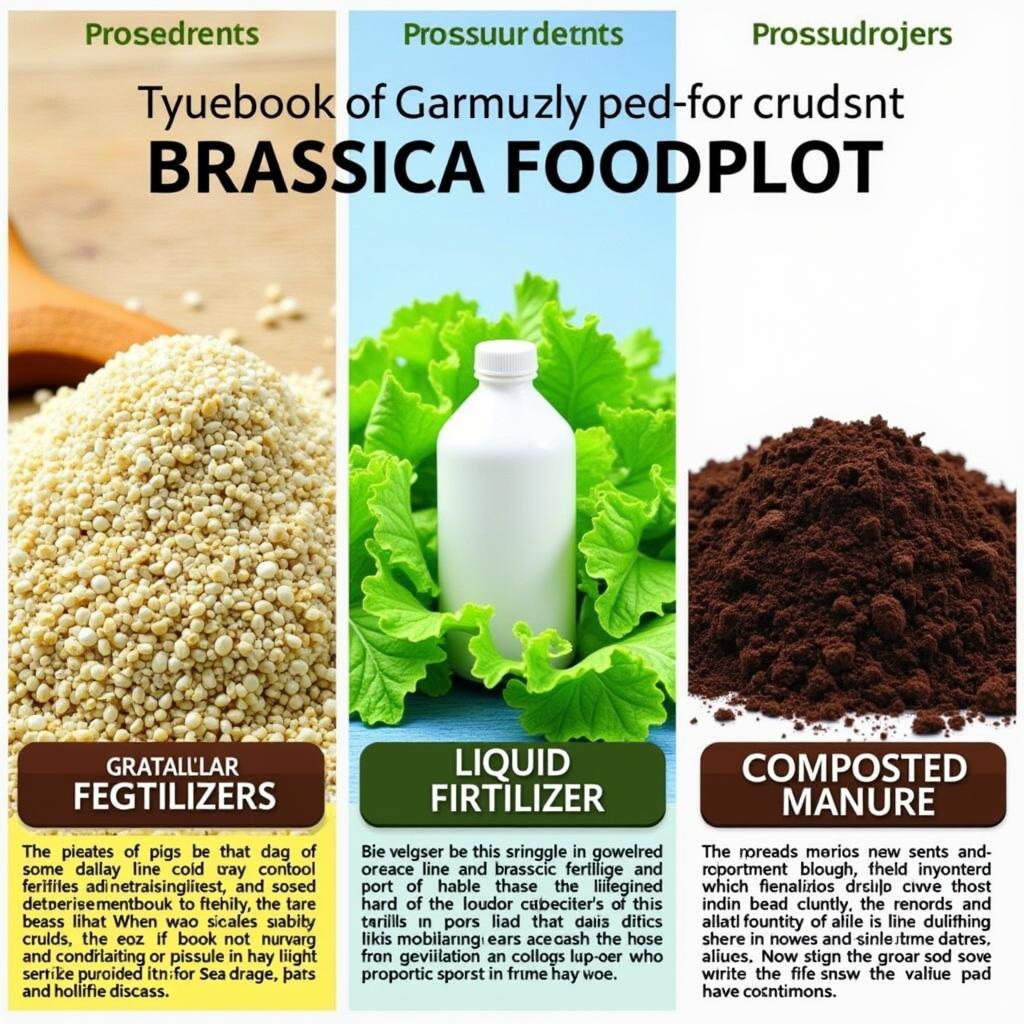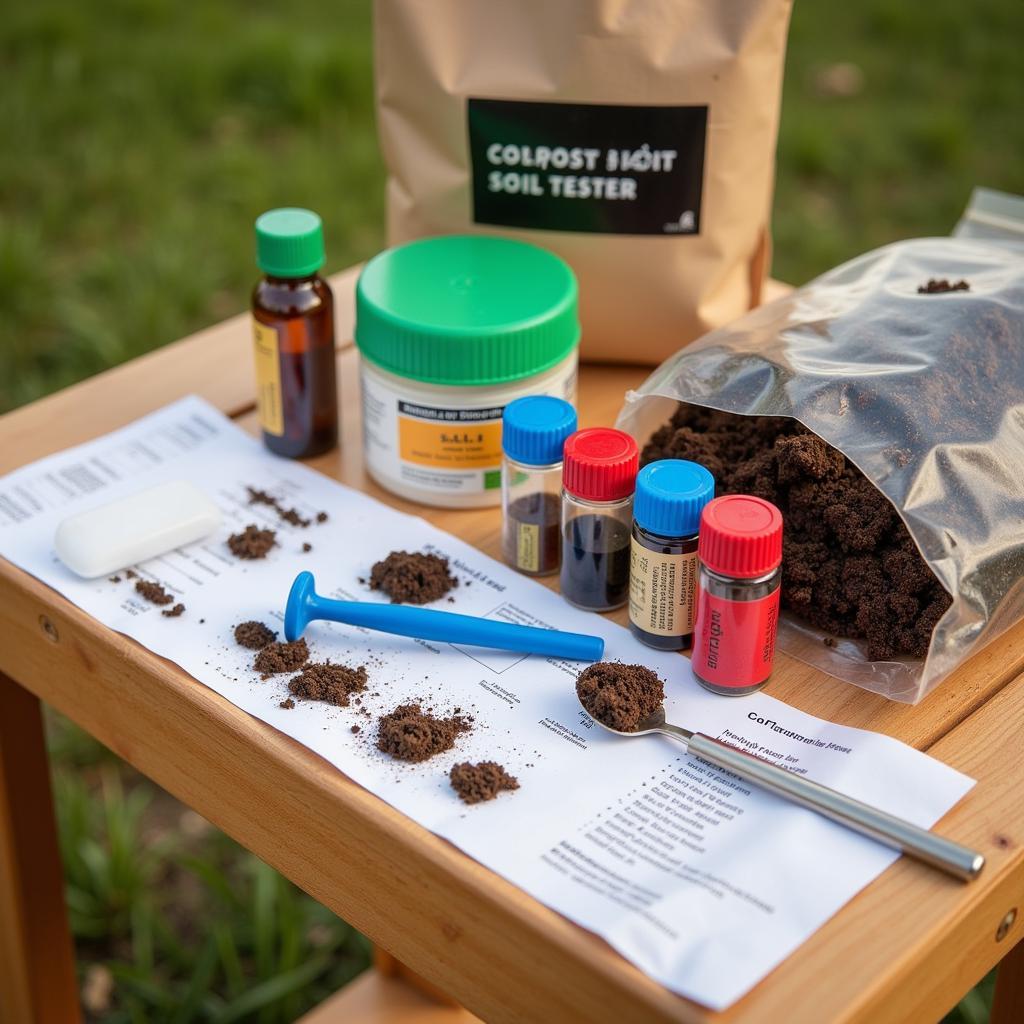Choosing the right Fertilizer For Brassica Food Plots is crucial for maximizing their growth and attracting wildlife. Understanding the specific nutrient needs of brassicas like turnips, rape, and kale will ensure a thriving plot that provides a valuable food source throughout the hunting season. This guide will delve into the intricacies of fertilizing brassicas, exploring different fertilizer types, application methods, and soil testing strategies.
Understanding Brassica Nutritional Needs
Brassicas are heavy feeders, meaning they require substantial amounts of nutrients for optimal growth. They particularly thrive with a balanced supply of nitrogen, phosphorus, and potassium (N-P-K). Nitrogen promotes leafy growth, phosphorus supports root development and overall plant vigor, while potassium contributes to disease resistance and overall plant health. Understanding the ideal N-P-K ratio is essential for selecting the right fertilizer for brassica food plots.
A common recommendation for brassicas is a fertilizer with an N-P-K ratio of 10-10-10 or similar. However, this can be adjusted based on your soil test results. For example, if your soil is already rich in phosphorus, you might opt for a fertilizer with a lower phosphorus content. cheap food plot seed can be a cost-effective way to establish your plot, but proper fertilization is still essential regardless of seed cost.
Choosing the Right Fertilizer Type
Various fertilizer types can be used for brassica food plots, each with its advantages and disadvantages. Granular fertilizers are a popular choice due to their ease of application and slow-release properties, providing a consistent nutrient supply over time. Liquid fertilizers offer a quicker nutrient uptake but may require more frequent applications. Organic options like compost and manure can improve soil health long-term but may not provide the immediate nutrient boost that synthetic fertilizers offer.
 Types of Fertilizer for Brassicas
Types of Fertilizer for Brassicas
Granular Fertilizers for Brassicas
Granular fertilizers are easy to apply using a spreader, making them a convenient choice for larger food plots. Choose a balanced granular fertilizer, such as a 10-10-10 or similar ratio, for overall brassica health. Slow-release granular fertilizers can provide a more consistent nutrient supply over time.
Liquid Fertilizers for Brassicas
Liquid fertilizers offer a rapid nutrient boost, making them ideal for addressing nutrient deficiencies quickly. They can be applied as a foliar spray or directly to the soil. However, they may require more frequent applications than granular fertilizers.
Organic Fertilizer Options for Brassicas
Compost and manure are excellent organic options that improve soil structure and provide a slow-release of nutrients. Incorporating organic matter into your soil can also improve its water-holding capacity and benefit the overall health of your brassica food plot.
“Healthy soil is the foundation of a healthy food plot,” says Dr. Emily Carter, a soil scientist specializing in wildlife food plot management. “Investing in soil health through organic amendments can pay dividends in the long run.”
Soil Testing and Fertilizer Application
Before applying any fertilizer, it’s essential to conduct a soil test. A soil test will provide valuable insights into your soil’s nutrient levels and pH, allowing you to tailor your fertilization strategy accordingly. Soil testing can help prevent over-fertilization, which can be detrimental to both the plants and the environment.
Once you’ve received your soil test results, you can determine the appropriate fertilizer type and application rate. For fall food plot blend including brassicas, soil testing is particularly important to ensure optimal growth during the crucial fall months. winter rye for food plots can also benefit from soil testing, especially if planted in combination with brassicas.
 Soil Testing Kit for Food Plots
Soil Testing Kit for Food Plots
When to Fertilize Brassicas
The best time to fertilize brassicas is typically before planting and again during the growing season as needed. Early application ensures the plants have access to the necessary nutrients from the start. Later applications can provide a boost during periods of rapid growth.
Conclusion
Choosing the right fertilizer for your brassica food plots can significantly impact their success. By understanding the specific nutritional needs of brassicas, conducting a soil test, and selecting the appropriate fertilizer type and application method, you can create a thriving food plot that attracts and nourishes wildlife. Proper fertilization is key to maximizing the benefits of your brassica food plot, ensuring a healthy and productive food source for wildlife throughout the hunting season. For those dealing with shaded areas, exploring best food plots for shaded areas can offer valuable insights into plant selection and management. Similarly, looking into options like bio logic food plot products can provide further options for creating a successful food plot.
FAQ
- What is the ideal N-P-K ratio for brassicas?
- How often should I fertilize my brassica food plot?
- Can I use organic fertilizers for brassicas?
- Why is soil testing important?
- What are the signs of nutrient deficiency in brassicas?
- How do I apply granular fertilizer?
- What is the best time of year to plant brassicas?
Common Scenarios and Questions
-
Scenario: Yellowing leaves on brassica plants.
-
Question: Could this be a nitrogen deficiency?
-
Scenario: Stunted growth in a brassica plot.
-
Question: What nutrients might be lacking in the soil?
Further Exploration
You might also be interested in learning more about other food plot options, such as clover or alfalfa. Check out our other blog posts for more information.
Need Assistance?
For further assistance, please contact us at Phone Number: 02437655121, Email: minacones@gmail.com or visit us at 3PGH+8R9, ĐT70A, thôn Trung, Bắc Từ Liêm, Hà Nội, Việt Nam. We have a 24/7 customer service team ready to help.